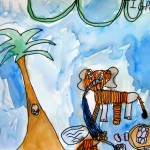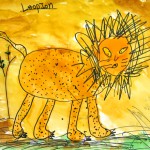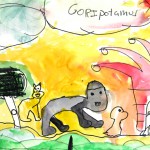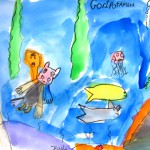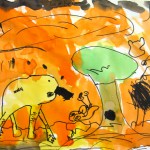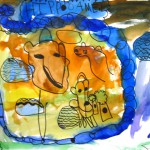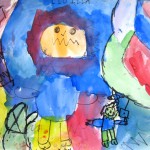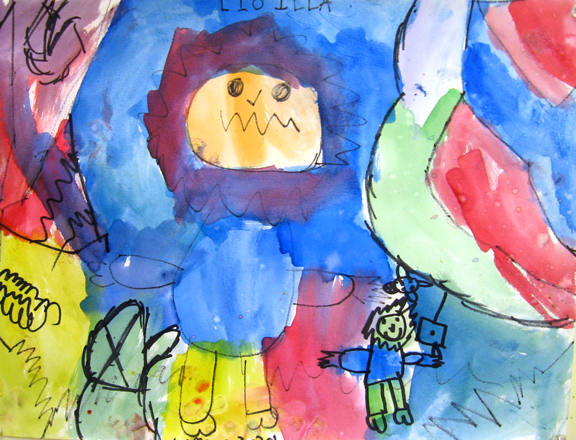
Categories
- Curriculum: Art | Science | Social Studies
- Age/Grade: Elementary 1 | Elementary 2 | Elementary 3
- Subject: Drawing | Painting
- Materials: Mixed Media | Paint | Oil Pastels | Clay
- Institution: School of Visual Arts
- Location: New York, New York
- Duration: 2 Classes
Description
THIS LESSON USES THE NYC BLUEPRINT LEARNING STANDARDS.
Elementary students design their own mix and matched animals, using a lesson framework that emphasizes transformation.
This lesson accompanies the following additional lessons:
"Clay for Fun"
"Cranimals in 3D"
"Paper Sculpture Habitats"
Objective
The students will learn about animals.
The students will have their literacy reinforced by working with pieces of animal names to invent a new animal.
The students will use their drawing skill.
The students will work cooperatively with a partner.
Resources
Nature photographs of animals
Keith Haring drawings and paintings (such as Untitled (Dogs Dancing) that show a combination of two forms, or one image that is half one things and half another).
Materials
Poster of Animal pictures with their names
Cut up pieces of animal names sorted into a "front half" pile and a "back half" pile, with a basket of each for each table
Exemplar
Pencils and erasers
Construction paper
Cray pas
Water colors and painting supplies (brushes, sponges, paper towels, water/cups)
Procedure
MOTIVATION
To engage the students creatively through melding different animals into a new one of their design.
VOCABULARY
Imagination, animal names, combine
PROCEDURE
DAY 1
Students will gather on the carpet. We will look at the animal poster.
Key Questions: Who can pick out some of the animals on this poster? Who can tell me about the different parts of each animal?
Students go to sit at desks: Today we are going to be making CRANIMALS! A Cranimal is an animal that you make up! Each table is going to get two baskets that will help you invent you Cranimals. There is a basket with blue cards that have a "front half" animal name piece, and a basket with yellow cards that have a "back half" animal name piece. Remember, the blue cards are for the front half, and the yellow cards are for the back half. What you are going to do is work with a partner - the one sitting next to you at your table! - and you are going to look through the blue front halves, and the yellow back halves until you find one of each that you want to combine. And when you and your partner have one blue front half and one yellow back half combined, then you have a CRANIMAL! Then you get to draw your Cranimal.
Exemplar: Now here are the two halves that I combined and here is my Cranimal. When you are drawing, remember all of the different animal parts that you picked out back on the carpet, like and elephant has a ...
Students work: Making up their Cranimals, then in pencil, and then cray pas until the end of the period.
Closure: At the end of the period I will walk around a pick out what some of the students are doing and show the group and ask questions about it.
DAY 2
Class will begin on the carpet with a review of the poster and of what the students are working on. Students will move back to their desks and continue to work on their drawings, as this will be the last class to finish them.
Closure: At the end of the period students will gather on the carpet and we will talk about the class's Cranimals. Students will then be shown the selected works of Keith Haring. They will discuss what his paintings are like, and how they relate to the work that they just did.
Extensions
Assessment: Students will be assessed during class time and by their work. Assessment will strive to understand: How well the students understood the idea of combining animals, how well they worked with a partner, behavior, and how well they participated in the final class discussion.
Enrichment & Reinforcement: The next lesson in the unit, Fun with Clay can act as a precursor to students creating their Cranimal in 3D (in the Cranimals in 3D lesson).
BLUEPRINT LEARNING STANDARDS FOR THE ARTS
1. Art Making: Students create drawings based on imagination, memory, and observation of photographs.
2. Literacy in the Arts: Students use pieces of animal names to form their new animal 3. Making Connections: Students engage in synthesis and creation.
5. Careers and Lifelong Learning: Students have to work with a partner for a segment of the lesson.
NY STATE STANDARDS EMPLOYED
1. Creating, performing, participating.
2. Knowing and using materials.
3. Responding and analyzing works of art.
The author of this lesson, Marie Antonelli, a Masters in Art Education student of the School of Visual Arts in NYC, is the 2005-2006 scholarship recipient of the Keith Haring Scholarship award. This project is a collaboration with The School of Visual Arts & a local NYC public high school.
To find out more about The Keith Haring Foundation Scholarship offered through the School of Visual Arts, please contact: Director, School of Visual Arts/Visual Arts Foundation, 15 Gramercy Park South, NYC 10003 or SVA's web site.
